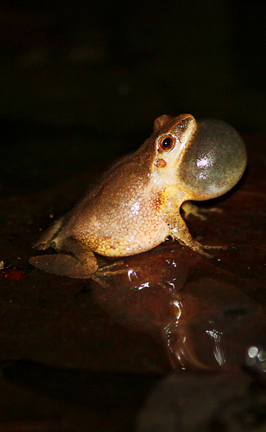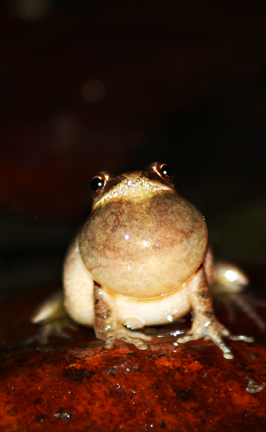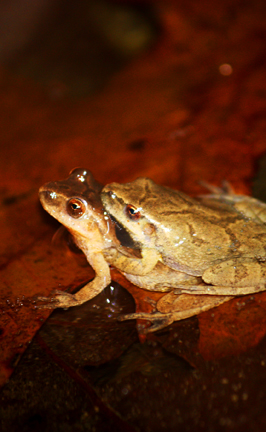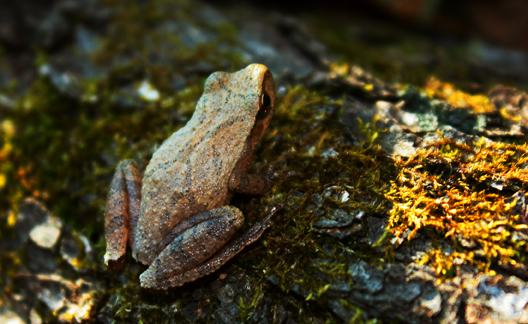Spring Peepers
by Ben Dalton
Spring peepers are some of the most iconic frogs of the Ozarks. These small tree frogs are given the scientific name Pseudacris crucifer. The genus name Pseudacris this comes from the Latin roots pseudes (think pseudo-) meaning false, and acris from the latin work akris, meaning locust. This name likely comes from the chirping calls some of these frogs make, and early explorers mistaking their calls for those of insects. The species name crucifer is pretty straight forward, and comes from the cross-like pattern these frogs bear on their backs.
Spring peepers prefer woodlands to open areas, and are found throughout most of the Eastern US. They extend as far west as eastern Oklahoma and Texas, but are prevented from radiating further by the Great Plains. Within the forests they seek our pools and marshes, never straying too far from water.
If you were to venture out on a rainy spring evening, the first sign of these little wonders wouldn’t be just their characteristic “peep” calls, but the distance from which you can hear them. After the snows melt and the ponds fill up, these are some of the first frogs to come out of hibernation.
The males typically emerge earlier, congregate at the newly-filled bodies of water, and begin their songs. Peepers range in size from under and inch to 1.5 inches when fully grown. While the high-pitched peeps they make might not sound loud to our ears, they are quite the feat for these little amphibians. When hundreds of males start calling, the chorus that results can be heard miles away.
Male peepers, all male frogs in fact, call like this to attract mates. However, not all calls equally entice the females. Body size is tied directly to the pitch of the call – larger males have the deepest calls.
In the frog pond, size does matter. In addition to deeper calls, the frequency of the calls matter to females. Calling is physically exhausting for the frogs — it is the most strenuous exercise they do all year! — with larger males able to call more often than smaller males.
Females start to move towards the ponds, searching for the male with the deepest, most frequent, calls. However, the females often encounter a number of other males along the way while trying to find the best donor for her eggs. Not wanting to let the opportunity pass, the other males grasp the female in a specific motion called amplexus.
Amplexus consists of the male frog on top of the female, grasping her around the waist with his arms. When a female has been amplexed by a male, it eventually stimulates her to deposit her eggs. Males will fight for the right to amplex a female. If a female passes by with a male already latched on, other males will try to kick the male off the back of the female. Again, the larger males have a better chance of kicking off smaller males from a prospective female.
One group of males, aptly named “satellite” or “sneaker” males, know they can’t compete with the deep-voiced giants of the inner pond, so they adopt another strategy for mating:
Smaller males will often remain silent, not calling, and wait around the edges of the pond for females to move past them. Then, when the females enter the edge of the pond, the smaller males latch on to the female and hold on as tightly as they can. This strategy is surprisingly effective. Even after a female has been amplexed by a sneaker male, she will continue on a little longer past other males. Other males will try to kick the smaller sneaker off, but while the other males used most of their energy calling the sneaker male devoted all his energy to keeping a firm grasp.
This is a sort of check and balance system of the frog pond that ultimately results in all sizes of frogs, not just the largest, reproducing and passing on their traits to the next generation.
Female peepers will deposit their eggs – sometimes over 1000 at a time – which are then fertilized by males. Tadpoles usually hatch from the eggs within a week or two, depending on the temperature. Unlike the adult frogs, tadpoles are completely aquatic, have gills, and eat plants. They will remain in the ponds for the majority of the summer, feeding on algae and growing.
After two or three months in the ponds, the tadpoles begin to sprout legs: rear legs first, then their front legs. After their legs are developed, their tail begins to shorten, and their gills start reabsorbing into their body as lungs are formed. This period of metamorphosis is an awkward period for a tadpole that is designed for aquatic life.
No longer can it use a long tail to move move quickly away from aquatic predators, or solely breathe water with its gills, nor can it fully hop about on land, nor breathe air exclusively. Sadly, the success rate for tadpoles making it to adulthood, successfully metamorphosing and returning to breed the following year, is abysmally low. Out of the clutch of over 1000, sometimes less than 10, if any at all, will return to breed.
April 6, 2014
PLATES 1-4 courtesy of Ben Dalton, PLATES 5-7 (Brush Creek & Four-Mile Road, rural Crawford County, Missouri, March 31, 2012), by Dale Grubaugh. StateoftheOzarks Archive.
Plate 1. Above, a spring peeper, Pseudacris crucifer. The species name, crucifer, comes from the cross-shaped pattern on the back.

Plate 2. A male spring peeper calls by inflating a vocal sac located directly under the jaw. Advertisement in this way can attract mates or warn other males to stay away.

Plate 3. Anterior view of the inflated vocal sac. Calling like this is the most energy-intense behavior a male frog will perform all year.

Plate 4. Two peepers in amplexus. Here, the smaller male is on top, grasping the female until she deposits her eggs which he will then fertilize.

Plate 5. Brush Creek, Crawford County, Missouri. March 31, 2012.

Plate 6. Brush Creek, Crawford County, Missouri. March 31, 2012.

Plate 7. Four-Mile Road, Crawford County, Missouri. March 31, 2012.




